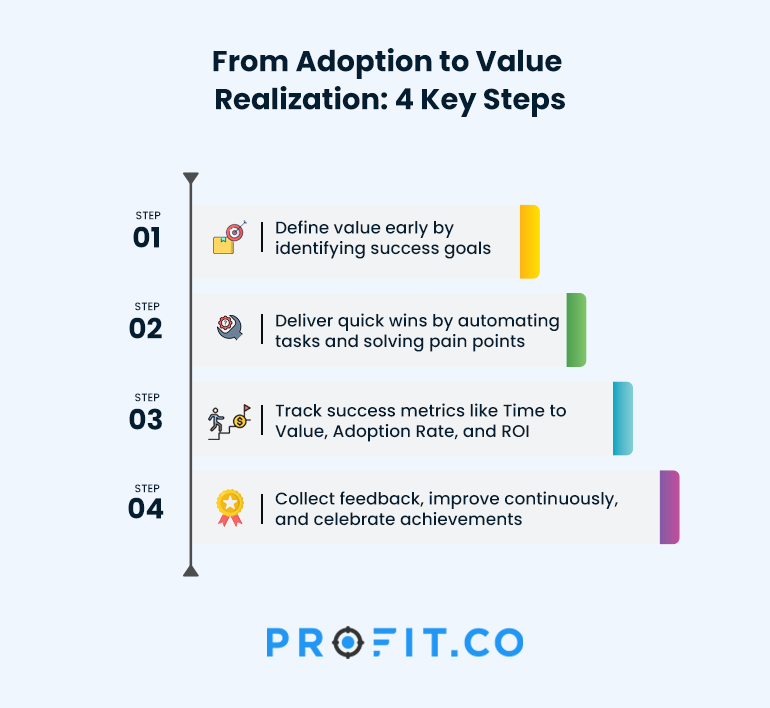Starting a new SaaS tool can feel like learning a new dance. At first, it’s all about figuring out the steps. But with the proper guidance, those awkward stumbles turn into smooth moves.
One key question is at the heart of any successful SaaS implementation: “How do we make this worth it?” You’re investing time, energy, and resources, so realizing value quickly is the ultimate goal. But here’s the thing value doesn’t just happen. It results from a strategic setup and a focused effort across your organization.
Ready to take the journey from setup to success? Let’s explore the roles, responsibilities, and best practices that help you realize the full potential of your SaaS tool.
The best way to create value in the 21st century is to connect Creativity with Technology
The 3 Key Roles for SaaS Success
Every SaaS implementation relies on three critical roles to drive value: The Champion, The Sponsor, and The Advocates. Each role brings something unique to the table. Together, they create a system that keeps everything moving in the right direction.
1. The Champion: The Captain of Value
Think of the Champion as your SaaS quarterback. They’re the go-to person for implementation, the architect of alignment, and ensuring everyone is rowing in the same direction.
Key Responsibilities:
- Designing the Strategy: The Champion tailors the implementation plan to fit your organization’s unique goals and culture.
- Training the Team: They ensure everyone knows the “why” and “how” of the SaaS tool. Workshops, webinars, quick reference guides they’re on it.
- Tracking Progress: By setting clear goals and monitoring adoption metrics, they ensure the tool delivers on its promise.
- Managing Change: Resistance is natural, but the Champion leads with clarity and communication to ease the transition.
Time Commitment:
Expect this person to dedicate 30–60% of their time to the implementation in the first quarter. Why so much? Because laying a strong foundation takes effort. Once the tool is up and running, their focus can shift to optimization and long-term success.
2. The Sponsor: The Leaders at the Top
The Sponsor is your SaaS cheerleader but make no mistake, this isn’t a passive role. They bring executive-level clout, ensuring the tool is prioritized and resourced appropriately.
Key Responsibilities:
- Public Endorsement: When leadership gets behind the tool, it sends a powerful message to the entire organization: This matters.
- Clearing Roadblocks: The Sponsor helps solve issues that could derail progress, whether it’s resource constraints or internal resistance.
- Recognizing Wins: Success deserves to be celebrated, and the Sponsor plays a key role in highlighting milestones and motivating the team.
Time Commitment:
A Sponsor’s time commitment is light around 5%. But their visible support is invaluable for driving adoption and enthusiasm.
3. The Advocates: The Departmental Champions
Advocates are the boots on the ground. They’re team leaders or influential players who understand the tool’s value and can rally their teams to adopt it.
Key Responsibilities:
- Cascading Objectives: Advocates break down company-wide goals into actionable steps for their teams.
- Providing Support: They’re the first line of defense for questions and challenges during the adoption phase.
- Driving Accountability: They ensure their teams stay on track by setting a tone of ownership.
Time Commitment:
Depending on the complexity of your organization, Advocates might spend 5–10% of their time championing the tool.
Make the Leap
From Adoption to Value Realization
The truth is the time you invest upfront will pay dividends later. However, realizing value goes beyond roles and responsibilities. It’s about creating a framework that keeps your SaaS tool relevant, impactful, and aligned with your goals.

But what does value realization mean?
Let’s break it down.
Step 1: Define Value from Day One
Before rolling out the tool, ask yourself: What does success look like?
- Is it streamlining processes?
- Cutting down manual work?
- Improving collaboration?
Define these outcomes clearly. Then, share them with your team so everyone works toward the same goals.
Step 2: Deliver Value Early and Often
Value doesn’t have to be a grand finale it can be incremental wins. Focus on delivering quick wins during onboarding to immediately show the tool’s potential.
For example:
- Automate a repetitive task that frustrates your team.
- Use analytics to surface insights that weren’t visible before.
- Solve a long-standing pain point within the first 30 days.
- These small victories build confidence and momentum.
Step 3: Measure What Matters
How will you know the tool is delivering value? Metrics. Track progress toward the goals you defined earlier.
Standard SaaS metrics include:
- Time to Value: How quickly users achieve their first success.
- Adoption Rate: How many users are actively engaging with the tool?
- ROI: The financial impact of using the tool compared to the investment.
Review these metrics regularly and adjust your approach as needed.
Step 4: Optimize Continuously
Value realization isn’t a one-and-done effort. It’s an ongoing process of listening, learning, and improving.
- Gather Feedback: What’s working? What’s not? Keep communication channels open so users feel heard.
- Iterate and Improve: Use feedback to tweak workflows, add features, or adjust training materials.
- Celebrate Wins: Regularly highlight how the tool makes a difference it reinforces its importance and keeps users engaged.
The Long-Term Payoff
When you set up your SaaS tool for success, you’re not just solving today’s problems but building a foundation for sustainable growth.
You’ll see:
- Greater Efficiency: Teams spend less time on manual tasks and more time on strategic work.
- Improved Collaboration: With everyone aligned, cross-departmental efforts become seamless.
- Happier Teams: A well-adopted tool reduces frustration and boosts morale.
And the best part? A successful implementation shows your team that change doesn’t have to be scary. It can be empowering.
Every SaaS tool has the potential to transform the way you work. But transformation doesn’t happen by accident. It takes a clear vision, dedicated roles, and a framework prioritizing value.
So, where will you start? Whether you’re the Champion ready to take the lead or the Sponsor eager to set the tone, the time to act is now.

